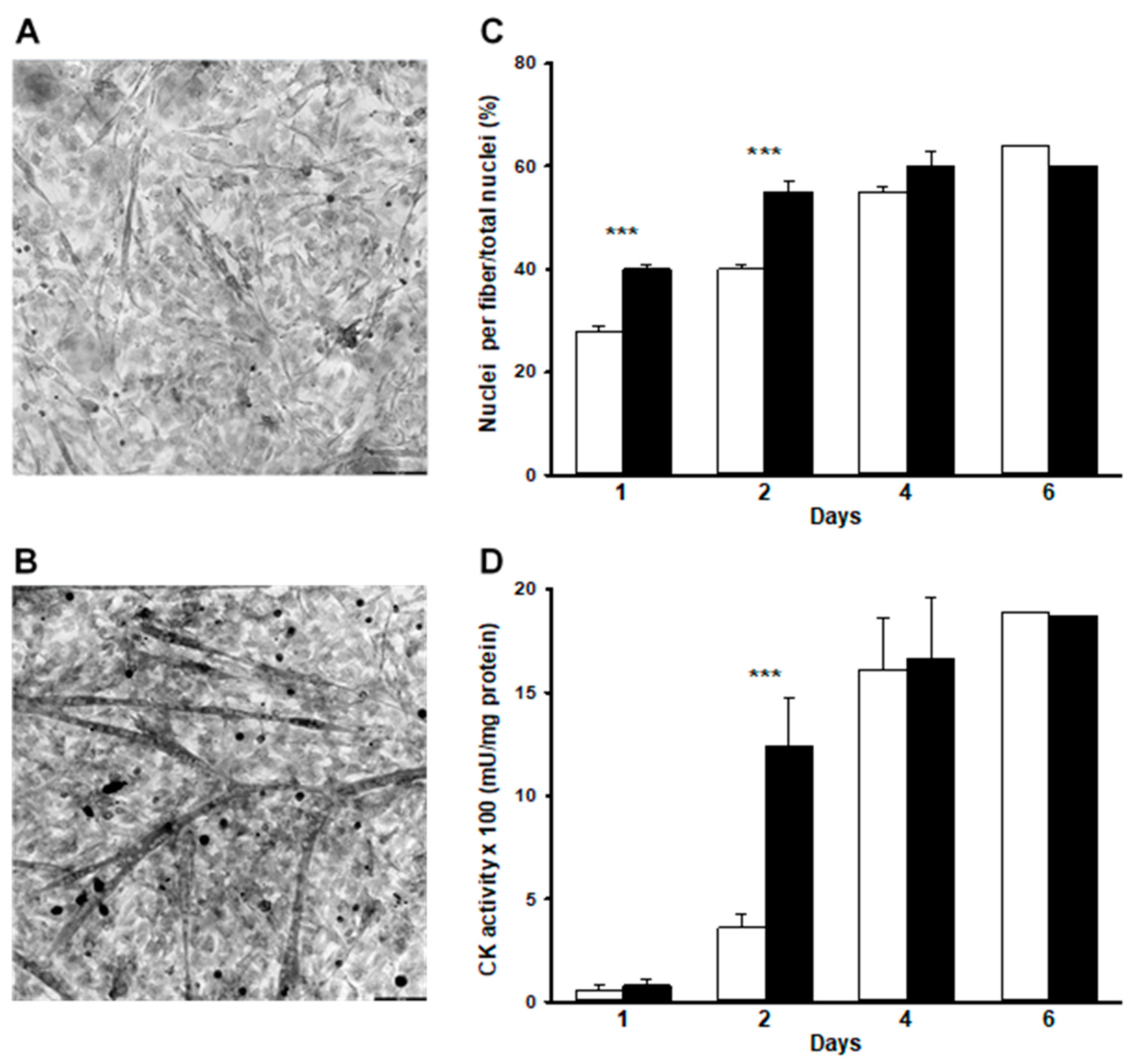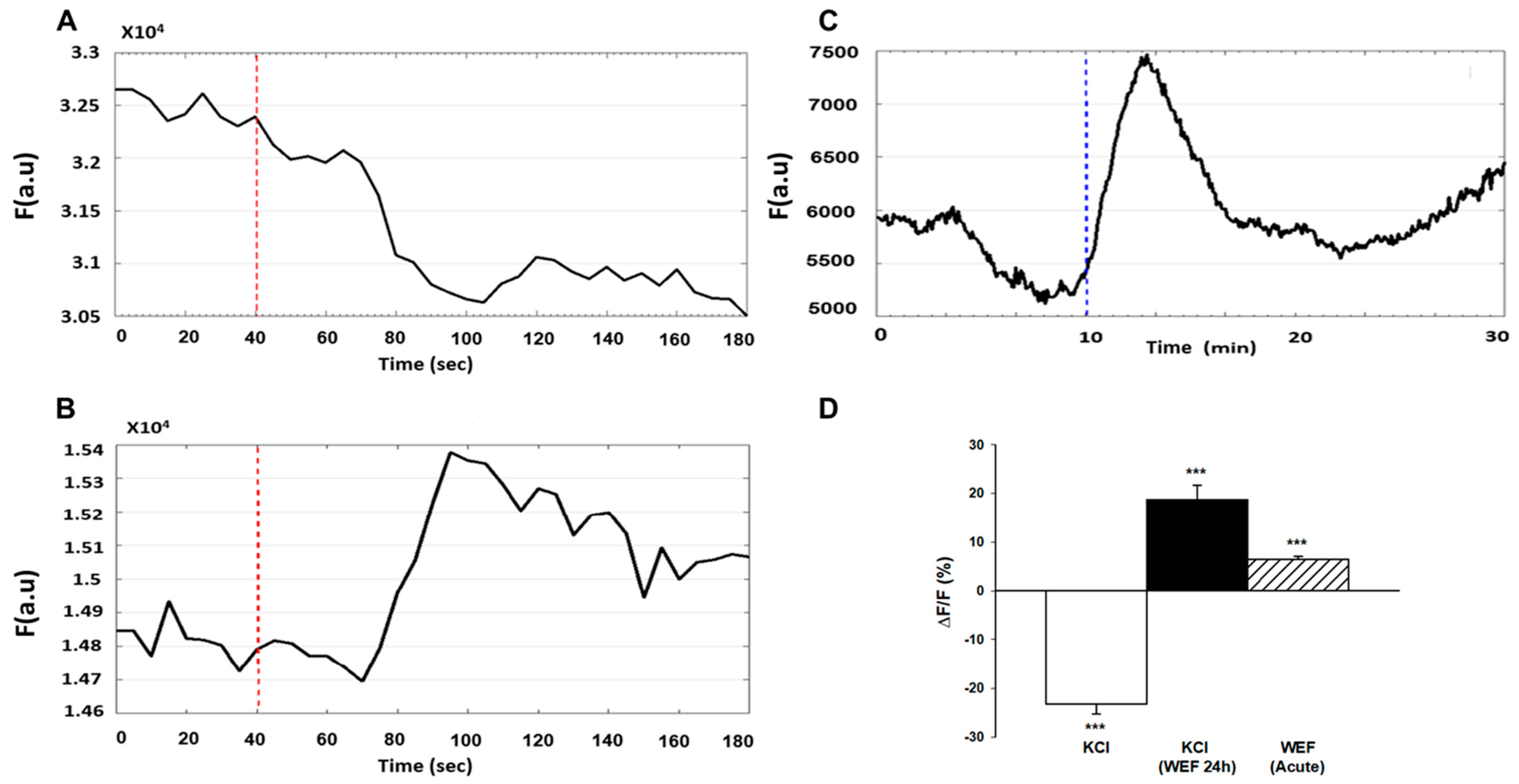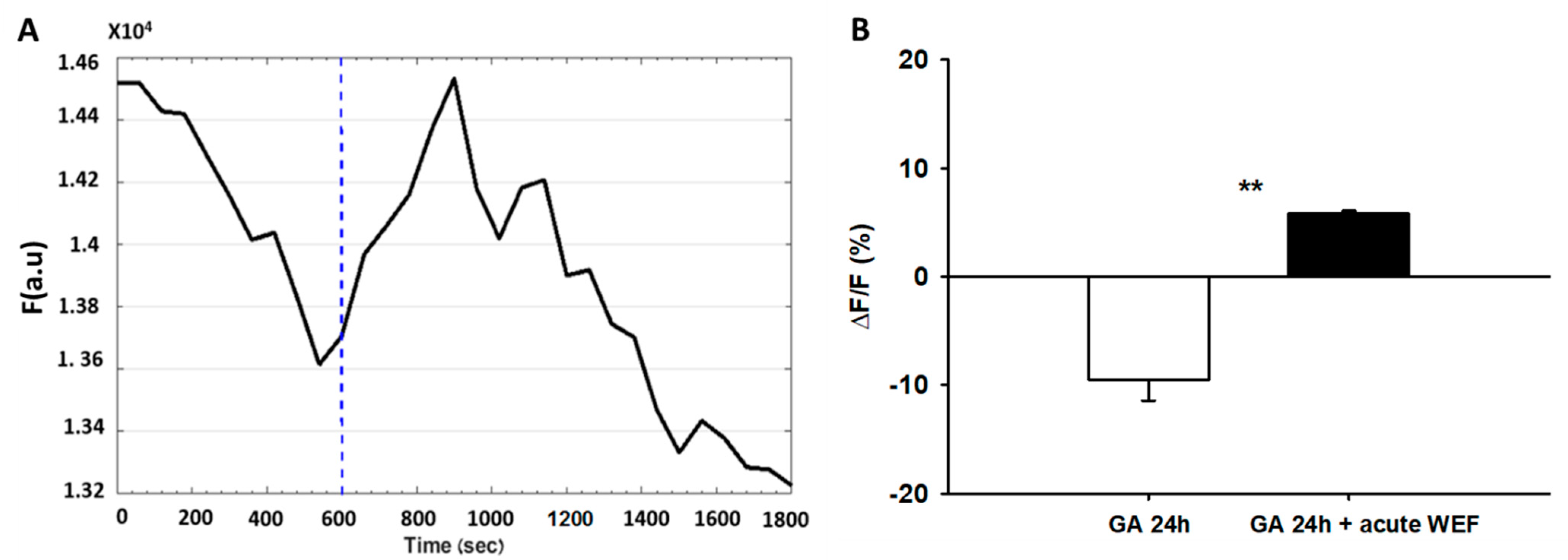Weak Electromagnetic Fields Accelerate Fusion of Myoblasts
Abstract
:1. Introduction
2. Results
2.1. WEF Accelerates Fusion
2.2. Ca2+ Is Required for Fusion
2.3. WEF Enhances Cell Replication
2.4. WEF Causes Membrane Hyperpolarization
2.5. WEF Does Not Activate Kir2.1 Channels
3. Discussion
4. Materials and Methods
4.1. Animals and Materials
4.2. Experimental
4.3. Analyses
4.4. Statistical
Author Contributions
Funding
Institutional Review Board Statement
Informed Consent Statement
Data Availability Statement
Acknowledgments
Conflicts of Interest
References
- Adey, W.R. Tissue interactions with nonionizing electromagnetic fields. Physiol. Rev. 1981, 61, 435–514. [Google Scholar] [CrossRef]
- Bawin, S.M.; Adey, W.R. Sensitivity of calcium binding in cerebral tissue to weak environmental electric fields oscillating at low frequency. Proc. Natl. Acad. Sci. USA 1976, 73, 1999–2003. [Google Scholar] [CrossRef] [PubMed] [Green Version]
- Pall, M.L. Electromagnetic fields act via activation of voltage-gated calcium channels to produce beneficial or adverse effects. J. Cell. Mol. Med. 2013, 17, 958–965. [Google Scholar] [CrossRef]
- Petecchia, L.; Sbrana, F.; Utzeri, R.; Vercellino, M.; Usai, C.; Visai, L.; Vassalli, M.; Gavazzo, P. Electro-magnetic field promotes osteogenic differentiation of BM-hMSCs through a selective action on Ca(2+)-related mechanisms. Sci. Rep. 2015, 5, 13856. [Google Scholar] [CrossRef] [Green Version]
- Walleczek, J. Electromagnetic field effects on cells of the immune system: The role of calcium signaling 1. FASEB J. 1992, 6, 3177–3185. [Google Scholar] [CrossRef]
- Adler, D.; Fixler, D.; Scheinowitz, M.; Shainberg, A.; Katz, A. Weak electromagnetic fields alter Ca2+ handling and protect against hypoxia-mediated damage in primary newborn rat myotube cultures. Pflügers Archiv-Eur. J. Physiol. 2016, 468, 1459–1465. [Google Scholar] [CrossRef] [PubMed]
- Elhalel, G.; Price, C.; Fixler, D.; Shainberg, A. Cardioprotection from stress conditions by weak magnetic fields in the Schumann Resonance band. Sci. Rep. 2019, 9, 1645. [Google Scholar] [CrossRef] [PubMed] [Green Version]
- Shainberg, A.; Yagil, G.; Yaffe, D. Control of myogenesis in vitro by Ca 2 + concentration in nutritional medium. Exp. Cell Res. 1969, 58, 163–167. [Google Scholar] [CrossRef]
- Shainberg, A.; Yagil, G.; Yaffe, D. Alterations of enzymatic activities during muscle differentiation in vitro. Dev. Biol. 1971, 25, 1–29. [Google Scholar] [CrossRef]
- Antigny, F.; König, S.; Bernheim, L.; Frieden, M. Inositol 1,4,5 trisphosphate receptor 1 is a key player of human myoblast differentiation. Cell Calcium 2014, 56, 513–521. [Google Scholar] [CrossRef]
- Schudt, O.; Pette, D. Influence of the ionophore A 23 187 on myogenic cell fusion. FEBS Lett. 1975, 59, 36–38. [Google Scholar] [CrossRef] [Green Version]
- Konig, S.; Hinard, V.; Arnaudeau, S.; Holzer, N.; Potter, G.; Bader, C.R.; Bernheim, L. Membrane Hyperpolarization Triggers Myogenin and Myocyte Enhancer Factor-2 Expression during Human Myoblast Differentiation. J. Biol. Chem. 2004, 279, 28187–28196. [Google Scholar] [CrossRef] [PubMed] [Green Version]
- Bijlenga, P.; Liu, J.-H.; Espinos, E.; Haenggeli, C.-A.; Fischer-Lougheed, J.; Bader, C.R.; Bernheim, L. T-type alpha 1H Ca2+ channels are involved in Ca2+ signaling during terminal differentiation (fusion) of human myoblasts. Proc. Natl. Acad. Sci. USA 2000, 97, 7627–7632. [Google Scholar] [CrossRef] [PubMed] [Green Version]
- Bernheim, L.; Bader, C.R. Human myoblast differentiation: Ca(2+) channels are activated by K(+) channels. Physiology 2002, 17, 22–26. [Google Scholar] [CrossRef]
- Benavides, D.T.; Egli, M. Calcium’s role in mechanotransduction during muscle development. Cell Physiol. Biochem. 2014, 33, 249–272. [Google Scholar] [CrossRef]
- Hindi, S.M.; Tajrishi, M.M.; Kumar, A. Signaling mechanisms in mammalian myoblast fusion. Sci. Signal. 2013, 6, re2. [Google Scholar] [CrossRef] [PubMed] [Green Version]
- Tanaka, S.; Ono, Y.; Sakamoto, K. DCEBIO facilitates myogenic differentiation via intermediate conductance Ca2+ activated K+ channel activation in C2C12 myoblasts. J. Pharmacol. Sci. 2017, 133, 276–279. [Google Scholar] [CrossRef]
- Chamberlain, J.S.; Jaynes, J.B.; Hauschka, S.D. Regulation of creatine kinase induction in differentiating mouse myoblasts. Mol. Cell. Biol. 1985, 5, 484–492. [Google Scholar] [CrossRef] [Green Version]
- Endo, T.; Nadal-Ginard, B. Three types of muscle-specific gene expression in fusion-blocked rat skeletal muscle cells: Translational control in EGTA-treated cells. Cell 1987, 49, 515–526. [Google Scholar] [CrossRef]
- Bedlack, R.; Wei, M.-D.; Loew, L. Localized membrane depolarizations and localized calcium influx during electric field-guided neurite growth. Neuron 1992, 9, 393–403. [Google Scholar] [CrossRef]
- Liu, J.-H.; Bijlenga, P.; Fischer-Lougheed, J.; Occhiodoro, T.; Kaelin, A.; Bader, C.R.; Bernheim, L. Role of an inward rectifier K+current and of hyperpolarization in human myoblast fusion. J. Physiol. 1998, 510, 467–476. [Google Scholar] [CrossRef] [PubMed]
- Bhave, G.; Lonergan, D.; Chauder, B.A.; Denton, J.S. Small-molecule modulators of inward rectifier K+channels: Recent advances and future possibilities. Future Med. Chem. 2010, 2, 757–774. [Google Scholar] [CrossRef] [PubMed] [Green Version]
- Zaks-Makhina, E.; Li, H.; Grishin, A.; Salvador-Recatala, V.; Levitan, E.S. Specific and Slow Inhibition of the Kir2.1 K+ Channel by Gambogic Acid. J. Biol. Chem. 2009, 284, 15432–15438. [Google Scholar] [CrossRef] [Green Version]
- Zanzouri, M.; Lauritzen, I.; Duprat, F.; Mazzuca, M.; Lesage, F.; Lazdunski, M.; Patel, A. Membrane Potential-regulated Transcription of the Resting K+ Conductance TASK-3 via the Calcineurin Pathway. J. Biol. Chem. 2006, 281, 28910–28918. [Google Scholar] [CrossRef] [Green Version]
- Valberg, P.A.; Kavet, R.; Rafferty, C.N. Can low-level 50/60 Hz electric and magnetic fields cause biological effects? Radiat Res. 1997, 148, 2–21. [Google Scholar] [CrossRef]
- Bassett, C.A.L. Beneficial effects of electromagnetic fields. J. Cell. Biochem. 1993, 51, 387–393. [Google Scholar] [CrossRef]
- Messerli, M.A.; Graham, D.M. Extracellular Electrical Fields Direct Wound Healing and Regeneration. Biol. Bull. 2011, 221, 79–92. [Google Scholar] [CrossRef] [Green Version]
- Whissell, P.D.; Persinger, M.A. Emerging synergisms between drugs and physiologically-patterned weak magnetic fields: Implications for neuropharmacology and the human population in the twenty-first century. Curr. Neuropharmacol. 2007, 5, 278–288. [Google Scholar] [CrossRef] [Green Version]
- Yaffe, D. Developmental changes preceding cell fusion during muscle differentiation in vitro. Exp. Cell Res. 1971, 66, 33–48. [Google Scholar] [CrossRef]
- Abmayr, S.M.; Pavlath, G.K. Myoblast fusion: Lessons from flies and mice. Development 2012, 139, 641–656. [Google Scholar] [CrossRef] [Green Version]
- Manno, C.; Figueroa, L.; Fitts, R.; Ríos, E. Confocal imaging of transmembrane voltage by SEER of di-8-ANEPPS. J. Gen. Physiol. 2013, 141, 371–387. [Google Scholar] [CrossRef] [PubMed] [Green Version]





Publisher’s Note: MDPI stays neutral with regard to jurisdictional claims in published maps and institutional affiliations. |
© 2021 by the authors. Licensee MDPI, Basel, Switzerland. This article is an open access article distributed under the terms and conditions of the Creative Commons Attribution (CC BY) license (https://creativecommons.org/licenses/by/4.0/).
Share and Cite
Adler, D.; Shapira, Z.; Weiss, S.; Shainberg, A.; Katz, A. Weak Electromagnetic Fields Accelerate Fusion of Myoblasts. Int. J. Mol. Sci. 2021, 22, 4407. https://doi.org/10.3390/ijms22094407
Adler D, Shapira Z, Weiss S, Shainberg A, Katz A. Weak Electromagnetic Fields Accelerate Fusion of Myoblasts. International Journal of Molecular Sciences. 2021; 22(9):4407. https://doi.org/10.3390/ijms22094407
Chicago/Turabian StyleAdler, Dana, Zehavit Shapira, Shimon Weiss, Asher Shainberg, and Abram Katz. 2021. "Weak Electromagnetic Fields Accelerate Fusion of Myoblasts" International Journal of Molecular Sciences 22, no. 9: 4407. https://doi.org/10.3390/ijms22094407
APA StyleAdler, D., Shapira, Z., Weiss, S., Shainberg, A., & Katz, A. (2021). Weak Electromagnetic Fields Accelerate Fusion of Myoblasts. International Journal of Molecular Sciences, 22(9), 4407. https://doi.org/10.3390/ijms22094407





